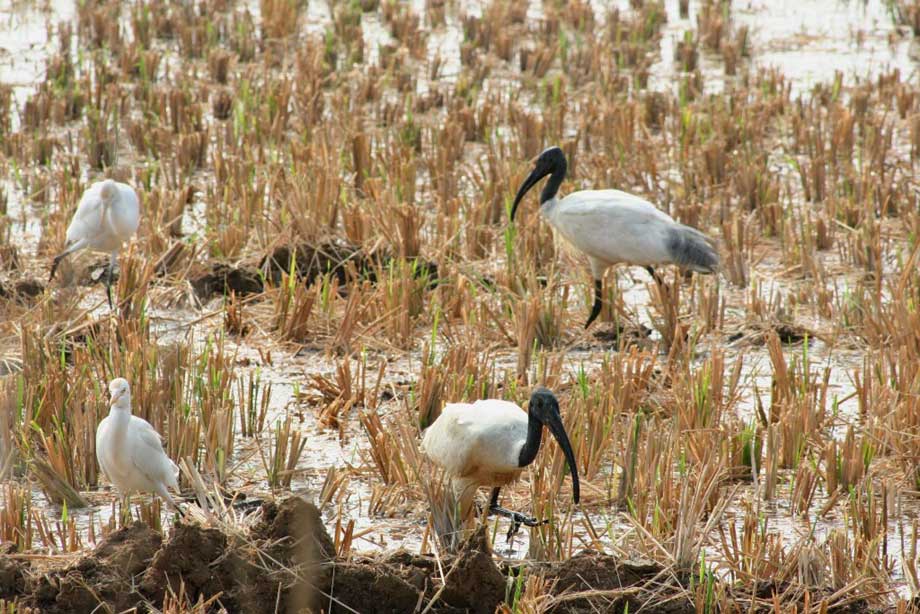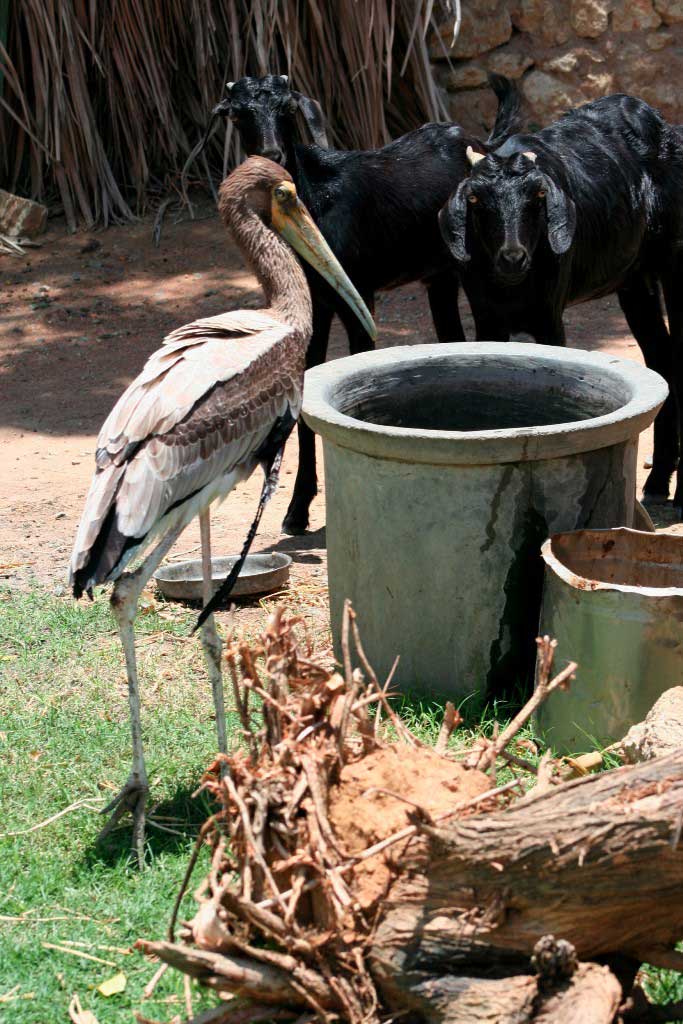Koonthankulam - Will It Survive The Impacts Of Climate Change?
By Veena M
24 May, 2014
Countercurrents.org

Painted Storks in their glory |Photo By Jean Nettar
Koonthankulam is an agriculture-oriented scenic village in the Thirunelveli district of Tamilnadu. It is located 35 kms. away from Tirunelveli in Tirunelveli Thisaianvilai Road comprising of Koonthankulam and Kadankulam tanks covering an extent of 129.33 hectares and declared as sanctuary in 1994. Its speciality is the well-balanced, conservation-based co-existence, protective mentality and positive attitude of human-beings towards life forms, especially a host of migratory birds, over a lakh in numbers. Winter visitors to this place, Painted storks, pelicans, whistling ducks, black and glossy ibises, spoon-bills and a host of others have a peaceful and well-protected co-existence here in this village, with the people.
With the onset of winter in their home countries, when food and living becomes a trial, these birds fly to warmer regions of the Earth in search of food and warmth. Then as elsewhere this village too becomes the breeding and feeding grounds to thousands of adult birds and nestlings. By May-June they grow up to their flying age and back to their growing grounds. Life has been beautiful and rhythmic to these thousands of feathered families until recently when global climatic change had its effects here too like elsewhere. The Babul plantation Accacia nilotica trees grown in the tank foreshores by the Social Forestry Division of Forest Department of 30 ha. in Koonthankulam and also the village trees is the main breeding ground.

Painted storks and pelicans |Photo By Jean Nettar
Like ice-bergs breaking up, lesser rains have been the scenario for South India over the last few years. There were rains up near the mountains, basically the rain-shadow regions of the Western Ghats, but not much rains blessed the low-lands. When each year the dams, up in Thambraparni river fills up, the over-flow was sent to fill up various tanks all around Thirunelveli district, and Koonthankulam tank was one of the beneficiaries. Filling up the tanks not only helped the farmers proceed with their agricultural jobs, but also helped thousands of migratory birds to enjoy their sustenance here with enough food in the form of fishes and crabs and planktons.
From 2012 onwards the scenario changed. There were lesser rains so less water reached the villages through canals. This meant not only less agriculture, but also less living creatures to be food for big birds and their ever hungry nestlings. This also meant lesser and lesser number of birds visiting and nesting in such villages over last two or three years. Also there was lesser guano (bird droppings for agriculture) and lesser nourishment of soils. Added to these impacts will be lesser number of nestlings which mean lesser number of adults to breed during the coming years.

Whit ibises |Photo By Jean Nettar
The saddest part of the story is when migratory birds lose a niche in such a place like Koonthankulam, it is not that they might not find other places to feed, nest and breed and feed their young. But rather that Koonthankulam, is a place where those whom we often call ‘illiterate’ people dwell (but who are absolutely literate in Nature’s ways), protect these birds young, old or weak alike. Moreover they tolerate these birds existence as if it is all one extended family. Even small kids obey these silent guidelines, which forms the base-flow of this community.
In most of the other places in the world people do hunt and eat birds, especially nestlings who can’t fly away. In other places birds are often attacked by domestic animals, dogs and cats. But in Koonthankulam, though occasionally one does find an old or a weak bird eaten by a dog, which is a very rare incident here. One can often see a weak bird having a drink alongside a goat or even walking through the village lanes like a sentry. The only village in India which refuses to use fire-crackers for Diwali or temple festivals is here, where people struggle very much for daily existence, but have the sensitivity to understand birds will be scared by the noise made by crackers. So one can blindly claim that nowhere else they can be as safe as these villages where they are protected and respected at the same time.

This is how the tank should be in February season, when the birds breed here |Photo By Jean Nettar
The visitors who ‘shoo’ off the birds to see them or photograph them in flight, on-the-wing, are known to be happily ‘shooed’ off by villagers for their uncouth behaviour. They tell you ‘You have no right to ‘shoo’ off the birds. What if they won’t come back?’ So when such birds lose such a corner in their world of existence the impact that is created in their world is so concrete and long-lasting. Fallen nestlings, hurt birds, old birds all are taken care of by the young and old in the community who are so interested and tender even though not trained. They teach the rest of the world a great example that it is good will that is needed far more than money and so called development to love and care about the ‘least of the beings’.
What is needed most?
‘Water - share/save some for us’ etc are the usual slogans for Governments and forest departments etc. But what we have recently forgotten is to send the most needed water to the places in the required quantity. In 2011, in Koonthankulam, there was water but not enough for a lakh of birds to survive there. In 2012 very little water reached so few birds that arrived made nest here. In 2013 and 2014 the water failed to reach here and so the birds abandoned the village. Koonthankulam bird sanctuary which is recognised globally as a very important sanctuary should receive its ample supply of water during the coming years. It’s the third consecutive year of very few numbers of Painted storks and pelicans and other stork varieties here. Agriculture activities are dying too.. Whistling ducks and bar-headed geese etc who need less water still arrive but no big birds come. The place looks bleak and deserted with the watch-tower looking like a scare-crow!

Young painted stork having a drink from within the village |Photo By Jean Nettar
Villages like Koonthankulam that offer protection to a country’s natural heritage should be given apt priority. Once water is there, the birds will come back and the community will take care of rest of the things. This should happen in spite of who is ruling the state or district. And it should happen quickly, there is no time to lose. If lakhs of gallons of water can be given to industries and power plants, water should come to Koonthakulam bird sanctuary too. Kudankulam Atomic plant uses millions of gallons of water every month but by contrast water once it comes here to the sanctuary stays there for long and nourishes farmers and birds alike... In the world tourist map Koonthankulam bird sanctuary is depicted as an attractive ground and for the biggest flocking of birds in South India. But if migratory birds vacate the place and farmers lose a living because of lack of water and if more than that water which is needed here is spent and polluted by industries and power plants, it will be a very sad fate for the people not just of Tamilnadu, but elsewhere too, who empathise with life-forms.
NB: The only sources of water at Kudankulam Nuclear Power Project are four desalination plants with a combined capacity of 10,000 cub meters per day. One of the plants will be on standby. The total reserve water in 11 tanks is 10,000 cubic meters, or equivalent to one and half days of production and two days of consumption.
The main raw materials used in a nuclear power plant are uranium and water. Daily requirement for one 1000 MW (e) reactor at Kudankulam is listed below:
Uranium235 0.003 Tons
Fresh and pure water for cooling the core – 3500 cubic meter (fresh water was to be brought from Pechiparai reservoir, 65 km south-west of the reactor site.)
Sea Water for condenser cooling - 7.2 million cub. Meter
This is what Wikipedia says about Koonthankulam
Koonthankulam Bird Sanctuary or Kunthankulam is a 1.2933 km2 (0.4993 sq mi) protected area declared as a sanctuary in 1994. It adjoins the tiny village of Koonthankulam in Nanguneri Taluk of TirunelveliHYPERLINK "http://en.wikipedia.org/wiki/Tirunelveli_district" district, Tamil Nadu, India. It is just 38 km away from Tirunelveli (a bustling town on the banks of the TambaraparaniHYPERLINK "http://en.wikipedia.org/wiki/Tambaraparani_River" River). 8.58102°N 77.76123°E It is composed of Koonthankulam and Kadankulam irrigation tanks, conveniently linked by tar road. This is the largest reserve for breeding water birds in South India. International name: Kunthangulam Bird Sanctuary, IBA Code: IN269, Criteria: A1, A4i.[1]
More than 43 species of resident and migratory water birds visit here every year. More than 100,000 migratory birds start coming by December and fly away to their northern homes by June or July after they lay and hatch eggs and the young ones mature enough to fly with the older ones.
Veena M is based in Trivandrum, working with a group called Eco-solutions which do ecological sanitation work
Comments are moderated

